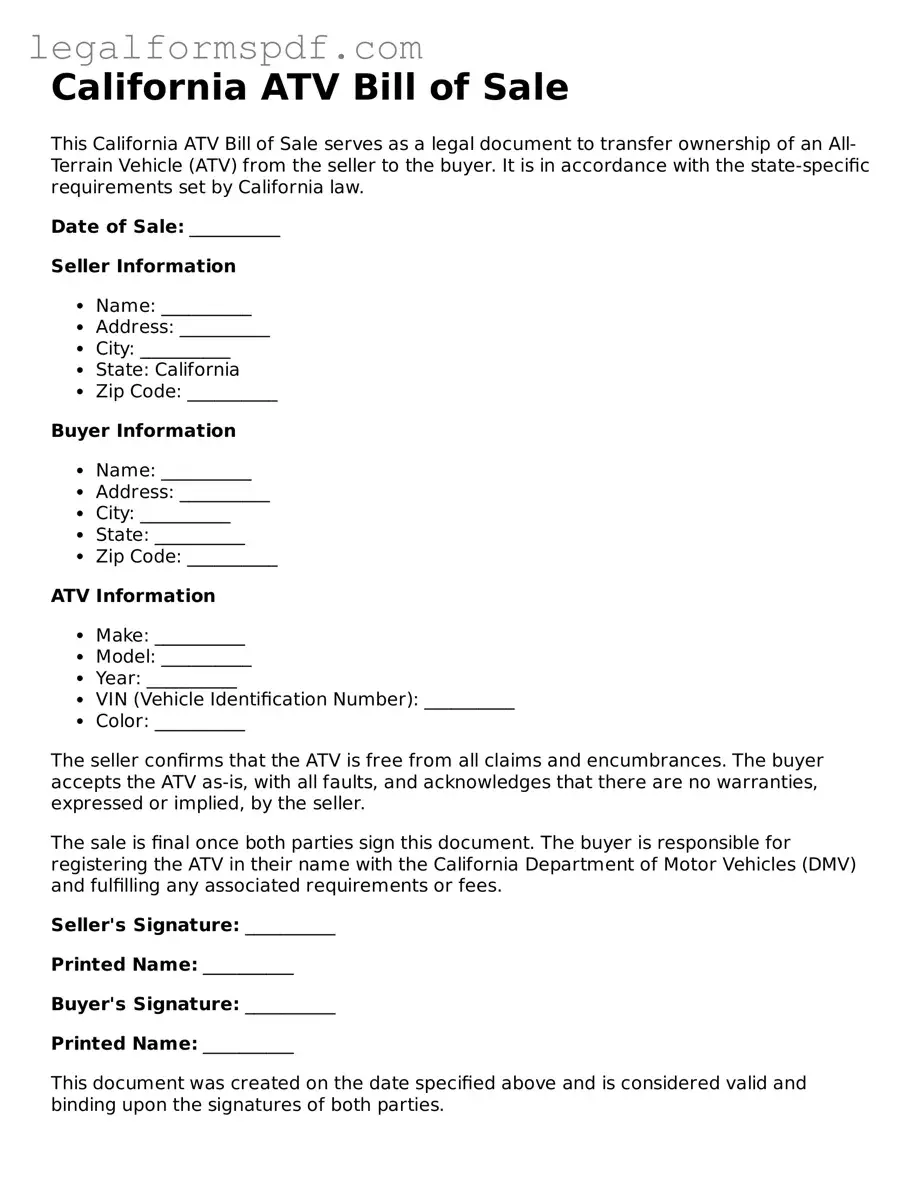What is a California ATV Bill of Sale form?
A California ATV Bill of Sale form is a legal document that provides evidence of the sale and transfer of ownership of an all-terrain vehicle (ATV) from the seller to the buyer. It includes important details about the sale, such as the date, sale price, and information about the vehicle and the parties involved.
Why do I need an ATV Bill of Sale in California?
Having an ATV Bill of Sale is crucial in California for a few reasons. It serves as a receipt for the transaction, helps to establish the new ownership of the ATV, and is required for the registration of the vehicle with the California Department of Motor Vehicles (DMV). It also provides legal protection for both the buyer and the seller in case any disputes or claims arise after the sale.
What information should be included in a California ATV Bill of Sale?
A comprehensive California ATV Bill of Sale should include the full names and addresses of both the seller and the buyer, the make, model, year, and Vehicle Identification Number (VIN) of the ATV, the sale date, the purchase price, and any other terms or conditions of the sale. Signatures of both parties are also necessary to validate the document.
Is notarization required for an ATV Bill of Sale in California?
No, notarization is not a requirement for an ATV Bill of Sale in California. However, having the document notarized can add an extra layer of authenticity and protection for both parties involved in the transaction.
Can I create an ATV Bill of Sale form myself?
Yes, you can create an ATV Bill of Sale form yourself as long as it includes all the required information. It's important to ensure that the document is clear, accurate, and includes all necessary details about the sale and the parties involved. There are templates available online, but it is advisable to tailor the document to meet your specific needs and legal requirements.
Do I need to register my ATV with the California DMV after the sale?
Yes, in California, you are required to register your ATV with the DMV after the sale. The ATV Bill of Sale form will be one of the required documents for this process. Registration ensures that your vehicle is legally recognized by the state, and it may also be necessary for the use of the ATV in certain public areas.
What happens if I lose my ATV Bill of Sale?
If you lose your ATV Bill of Sale, it's advised to contact the other party involved in the transaction and request a copy. If that's not possible, you might need to draft a new document and have it signed again. Keeping a digital copy of the bill of sale can help avoid such issues in the future.
Is the California ATV Bill of Sale form different from other vehicle bill of sale forms?
While the basic concept of a Bill of Sale is the same across different types of vehicles, the specific information and details might vary. For an ATV, the form will specifically cater to the type of vehicle, including details that are unique to ATVs, such as the make, model, and VIN specific to off-road vehicles.
How can I ensure that my ATV Bill of Sale is legally binding?
To ensure that your ATV Bill of Sale is legally binding, make sure that it includes all necessary information accurately and that it is signed by both the buyer and the seller. While notarization is not required, it can strengthen the legal standing of the document. It is also advisable to consult with a legal expert if you have any questions or concerns regarding the Bill of Sale.
